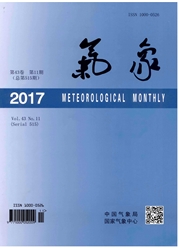

 中文摘要:
中文摘要:
MJO模拟及预报是现阶段大气科学研究的前沿问题。本文利用中科院大气物理所大气环流模式(IAP AGCM4.1)的集合回报结果,分析了MJO潜在可预报性及预报技巧。研究表明IAP AGCM4.1对MJO有着较好的潜在可预报性,且集合预报的潜在可预报性要明显优于单样本预报;就MJO的预报技巧而言,集合预报同样优于单样本预报;模式对MJO的预报技巧还显著依赖于预报初始时刻的MJO状态,初始MJO信号越强,模式对MJO的预报技巧也越高,且更接近可预报性的上限。
 英文摘要:
英文摘要:
A 30-year hindcast was performed using version 4.1 of the IAP AGCM(IAP AGCM4.1), and its potential predictability of the MJO was then evaluated. The results showed that the potential predictability of the MJO is 13 and 24 days, evaluated using the signal-to-error ratio method based on a single member and the ensemble mean, respectively. However, the MJO prediction skill is only9 and 10 days using the two methods mentioned above. It was further found that the potential predictability and prediction skill depend on the MJO amplitude in the initial conditions. Prediction initiated from conditions with a strong MJO amplitude tends to be more skillful. Together with the results of other measures, the current MJO prediction ability of IAP AGCM4.1 is around 10 days, which is much lower than other climate prediction systems. Furthermore, the smaller difference between the MJO predictability and prediction skill evaluated by a single member and the ensemble mean methods could be ascribed to the relatively smaller size of the ensemble member of the model.Therefore, considerable effort should be made to improve MJO prediction in IAP AGCM4.1 through application of a reasonable model initialization and ensemble forecast strategy.
 同期刊论文项目
同期刊论文项目
 同项目期刊论文
同项目期刊论文
 期刊信息
期刊信息
